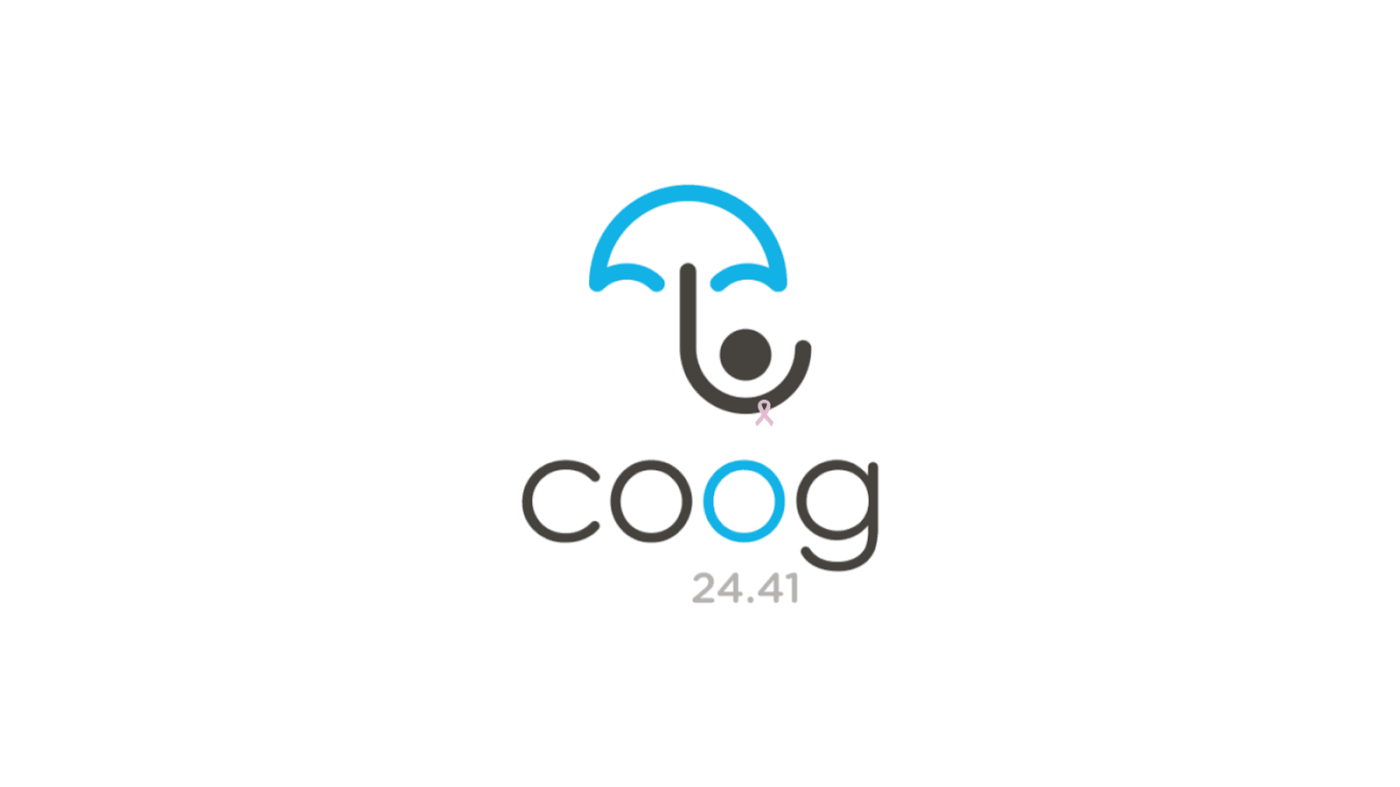
october 11, 2024 Release notes
Three coog advance developments in this new version of coog:
- Two regulatory projects, with the upgrade of the PASRAU module and the automation of LCB-FT management in coog,
- A cross-functional topic with the creation of a third-party summary view.
Another major new feature of coog 24.41 for the healthcare sector is the management of the NOEMIE standard in coog.
coog advance
Features reserved for contributors to the evolutive maintenance offer.
Person overview / 360° view of third parties
Business need
To enable managers to quickly access a summary of information relating to a third party (natural person / legal entity):
- Contract level,
- Benefit level.
Example: quickly answer the phone to a policyholder or a company.
Evolution summary
Dedicated “360° view of third parties” entry point
Choice of block organization: each block can be unfolded. When this person overview is opened, certain blocks are unfolded by default. The accordion view is a new graphic component in coog!
You can search for a third party by third party no., contract no., quotation no., surname, first name, etc.
The overview screen includes :
- Third-party data at the date of consultation
- Example: for a policyholder who has changed address, the current address on the date of consultation is displayed.
- Contracts and quotes: click on a record to open it.
- List of policyholders on the contract, with start and end dates
- List of endorsements on the contract: click on the endorsement number to open the details.
- Claims files: status, state (paid, scheduled, etc.), loss descriptor, loss start date and, if applicable, loss file closure date,
- and so on.
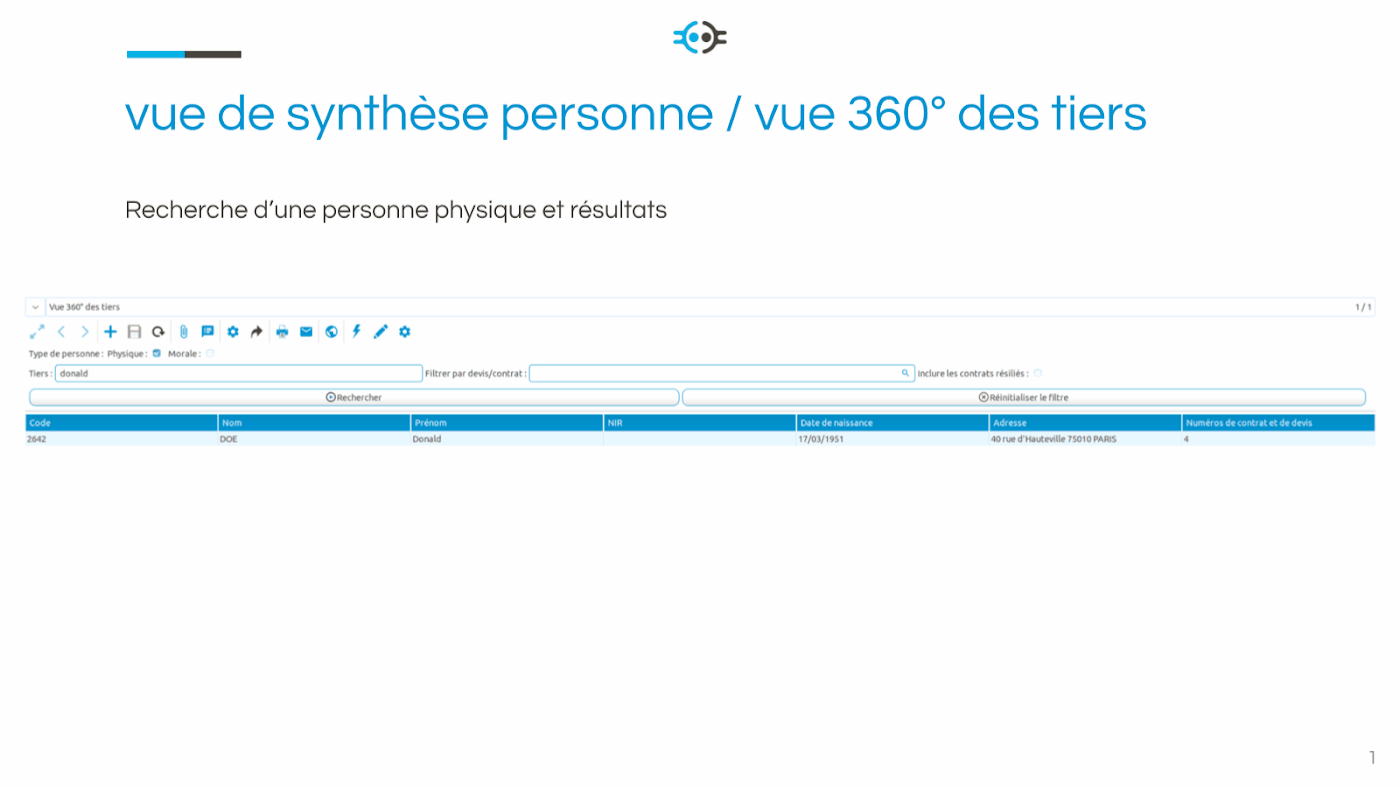
PASRAU
Delivered enhancements
- Implementation of an interface for declaration configuration (contact, etc.)
- Enable checks to be carried out upstream of actual flow generation – check on NIR for 2024
- Creation of sequences for managing business and legal identifiers
- Management of deduction details (management of subsequent tables)
- C3P: Codification Précision sur Prestation PASRAU (Precision coding of PASRAU benefits)
- CLREV: Income class
- CTP : Personnel Type Codes
- CCERP: Contributions, Exemptions, Reductions – Individual contributions PASRAU
- CBAP: PASRAU taxable base codes
- Structure evolution S10 – Sending
- Structure evolution S20 – Declaration
- Structure evolution S21 – Business data
- PASRAU slip generation wizard (manual)

coog Back-Office
Regulatory
LCB-FT management in coog
Context in the insurance sector
What are we talking about?
- Anti-money laundering
- Terrorist financing
- Insurance is a link in the chain, and all links in the chain protect each other from any loopholes.
What are the sources?
- Fourth European Anti-Money Laundering Directive > June 04, 2015
- FATF
- Case law, particularly ACPR sanctions in France
Developments
Standard connector with BeCLM screening solution (subscription required)
- Visualization of AML/CFT risk in linked records
- Verification of potential risk in BeCLM application
- Risk update in coog
- Automatic checks on management actions presenting a potential LCB-FT risk
- For example, the activation of a contract is blocked for a confirmed risk, as is the creation of an outgoing payment.
- Automated risk update (call back) reserved for coog advance contributors
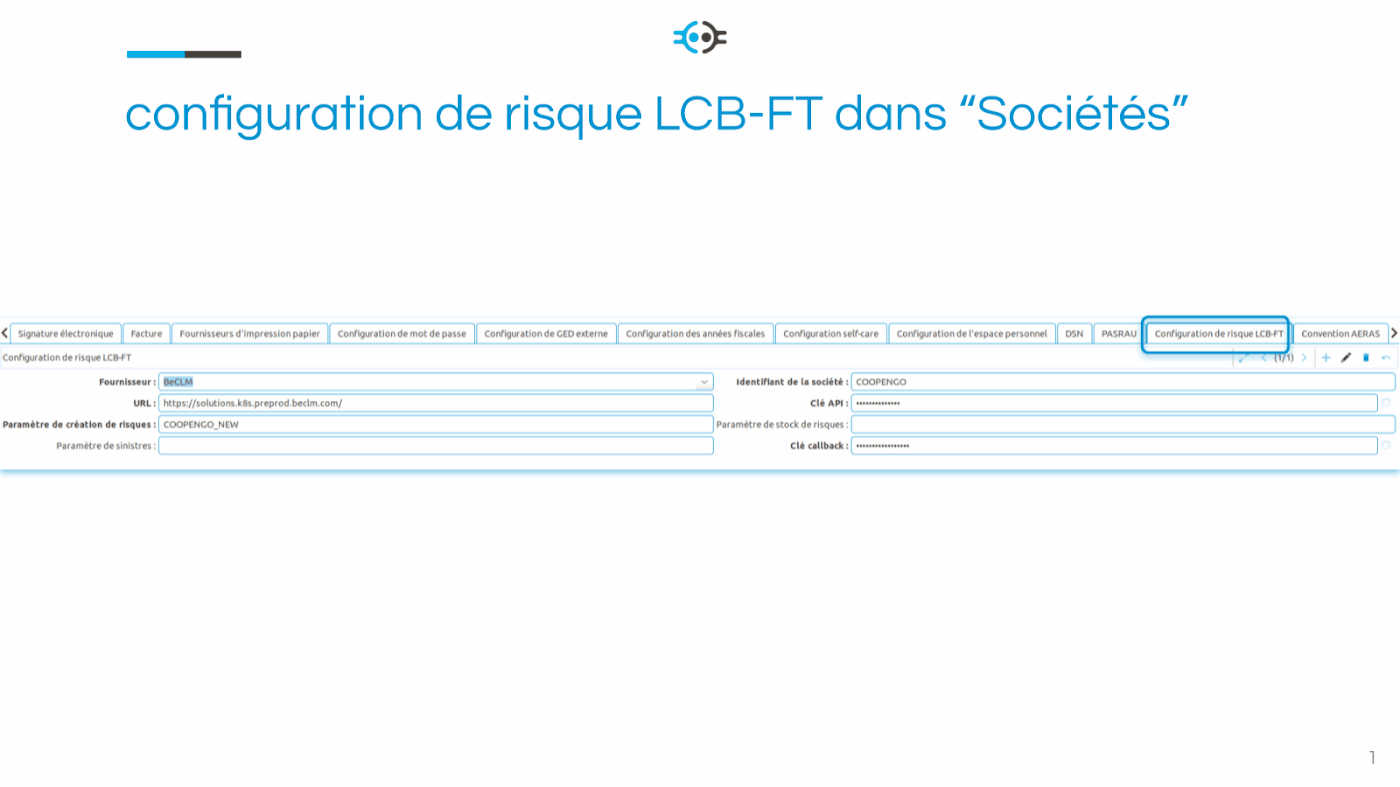
DSN
Context: the DSN module is designed to connect to various connectors.
Integration of net-entreprises.fr SEPA mandates
Evolution: net-entreprises.fr provides a mandate generation service. coog can now load mandates from their file.

Creation of a batch for processing intermediate collection objects (primers).
Evolution: this is the first step in enabling electronic payment via DSN.

Creation of a telepayment assignment batch
Evolution: enables telepayments made to be linked to call slips for settlement.

Healthcare
NOEMIE standard
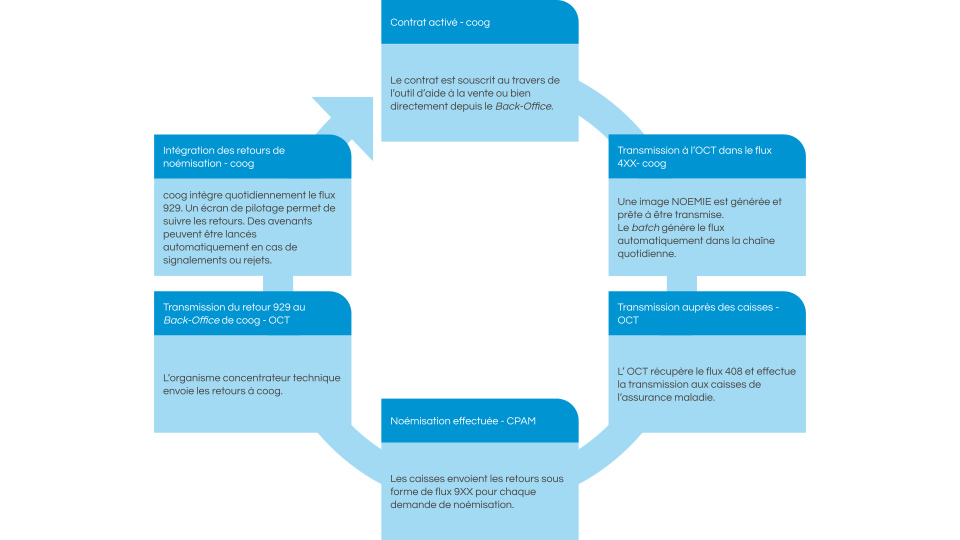
NOEMIE standard management in coog
Materialization of agreements between the complementary organization (and the STO) and the health insurance funds
Features
- Creation and configuration of technical concentrator organizations (OCT)
- Activation of NOEMIE 408 flows for a given complementary organization and product
- Configuration of fund agreements
These new features make it possible to block the sending of a flow if NOEMIE teletransmission has not been activated with the fund on the date of sending.
Creation of the NOEMIE 408 flow via the technical concentrator.
Features
- Automatically send NOEMIE and change requests (fund, name, etc.) from coog to the health insurance funds via the technical concentrator.
- View information sent in the NOEMIE flow (NOEMIE images)
- Control to avoid incomplete and therefore rejected flows
Materialization of NOEMIE 929 returns
This upgrade enables NOEMIE returns to be managed automatically or manually in coog, thanks to :
- Receipt of the return code (change of till, overlapping contracts, etc.),
- Recycling of returns in the event of an integration error (rejection or notification).
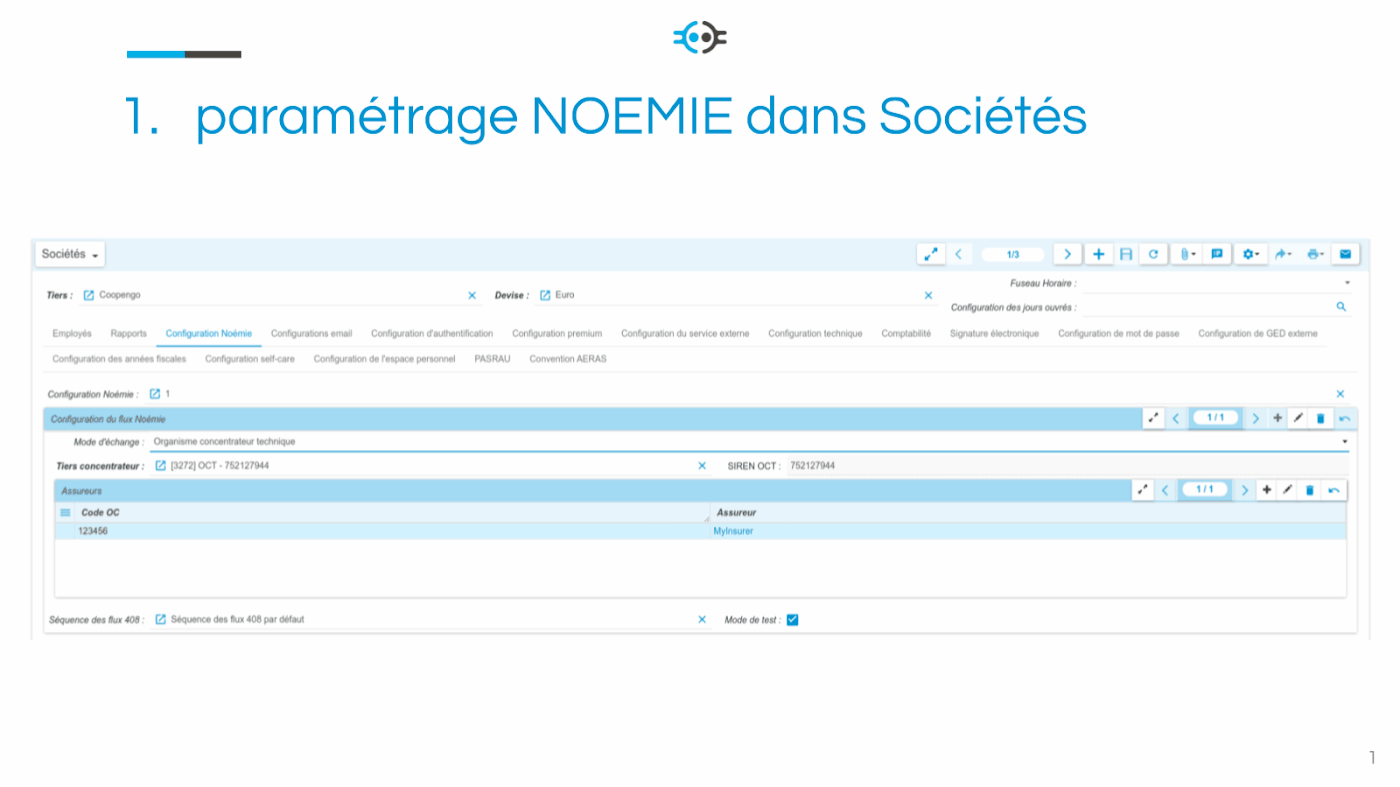
Policyholder Noemization Management” addendum
Evolution: allow users to modify the start and end dates of teletransmission.
almerys
Configuration of page backgrounds for third-party payment cards in the V3 interface with almerys.
Provident business line
Management of beneficiary designations in coog
Business needs
- Validate the legal relevance of free clauses for a risk carrier
- To be able to consult the previous version of the beneficiary clause
Evolution
This functionality enables clauses to be associated with an authorization group, thus forcing them to be controlled by authorized persons.
Quotations blocked at this stage will be found in the coog task management.
Transversal functions
Real-time synchronization of events between coog Back-Office and external tools (OAV, insured area, CRM, etc.).
Evolution
Publication of coog events to the outside world, enabling our users to consume them and display information synchronized with coog.
The brick is designed to call a client API, which is responsible for consuming these coog events and propagating them to the client’s IS.
Business case: a sales representative can monitor the progress of a risk analysis from his sales support tool.
Adding commercial discounts in euros to a contract
Evolution
coog used to let you set discounts by rate and duration. It is now possible to have flat-rate reductions.
Example: 50 euro discount on contract premiums for all new policyholders.
Add automatic process monitoring tasks
Evolution: process progress can be tracked via tasks created and updated automatically at each step change.
The steps in a dunning procedure can be parameterized according to the balance of a contract.
Example: trigger a dispute procedure if the amount outstanding exceeds a certain threshold.
Contracts
Added rules for generating documents following a risk analysis
Evolution: documents can be requested automatically for risk analyses that are accepted with conditions.
Use cases
In the case of contracts involving a risk analysis at underwriting, it is possible that this may result in an additional premium or a coverage exclusion. In such cases, a risk analysis decision may be made to “accept with reservations”, which may require the issue of a new policy including these additional premiums or exclusions.
In this case, it is now possible to automatically create (by configuration) a compulsory document enabling the new signed contract to be received (either manually or with an electronic signature).
Group contracts
Automatically manage the payee using the date of leaving the workforce as a selection criterion
Context
In group benefits, it is sometimes necessary to pay the company (as it continues to pay the employee’s salary) for a certain period of time before paying the insured person directly.
This is because, most of the time, the date of termination of the employment contract is communicated to the management departments after it has been implemented.
The evolution therefore consists in being able to manage the payment recipient automatically, using the date of leaving the workforce as a selection criterion.
Evolutions :
- Addition of a wizard for updating the termination date of an affiliation,
- Update of the “Modification of affiliations” rider,
- Automatic determination of payee.
TA (rate A) rate structure added to rate schedules only
Endorsements
The birth rank can now be modified through the birth date change endorsement.
Claims
Changes to a priori control of benefits and to the chain of control of benefits before disbursement
Three changes are concerning the a priori control of individual and group benefits
Checking a benefit according to the role of the manager who entered the benefit
Business case
More errors are expected from a new servicer than from an experienced one. With this development, it is now possible to set a 100% check for new servicers and a 30% check for experienced servicers.
Activate technical history on the “Claims configuration” object
Context
Control and validation thresholds can be modified, for example, in the event of a change of authority by the Board of Directors of a provident institution for instance. It is therefore necessary to be able to make these changes and keep a record of them.
Evolution: version the configuration object (“Claims configuration” and its sub-objects) which will carry the parameters of the control rule and the claims validation rule.
Identify a claim created automatically by batch
Evolution: identify from an engine rule (deductible, benefit, revaluation, control, validation, etc.) whether it is a calculation launched by a servicer or carried out by coog processing.
Business case
As the person in charge of control, I don’t want to subject benefits automatically calculated by coog to a priori control, in order to save time and spend more time where the risk is greater.
Group insurance claims
Creation of a tool to simulate and create compensation periods
Context: the tool is designed to connect to different connectors.
Developments :
- Functionalities for simulating compensation periods based on data loaded in a pivot format,
- Compensation creation functionalities.
Overhaul of the salary entry tool
Evolution: creation of a new tool that simply displays the information to be completed by the servicer.
Example: this is a real wizard that allows the manager to duplicate an amount entered, or to apply a global value to all lines, etc.
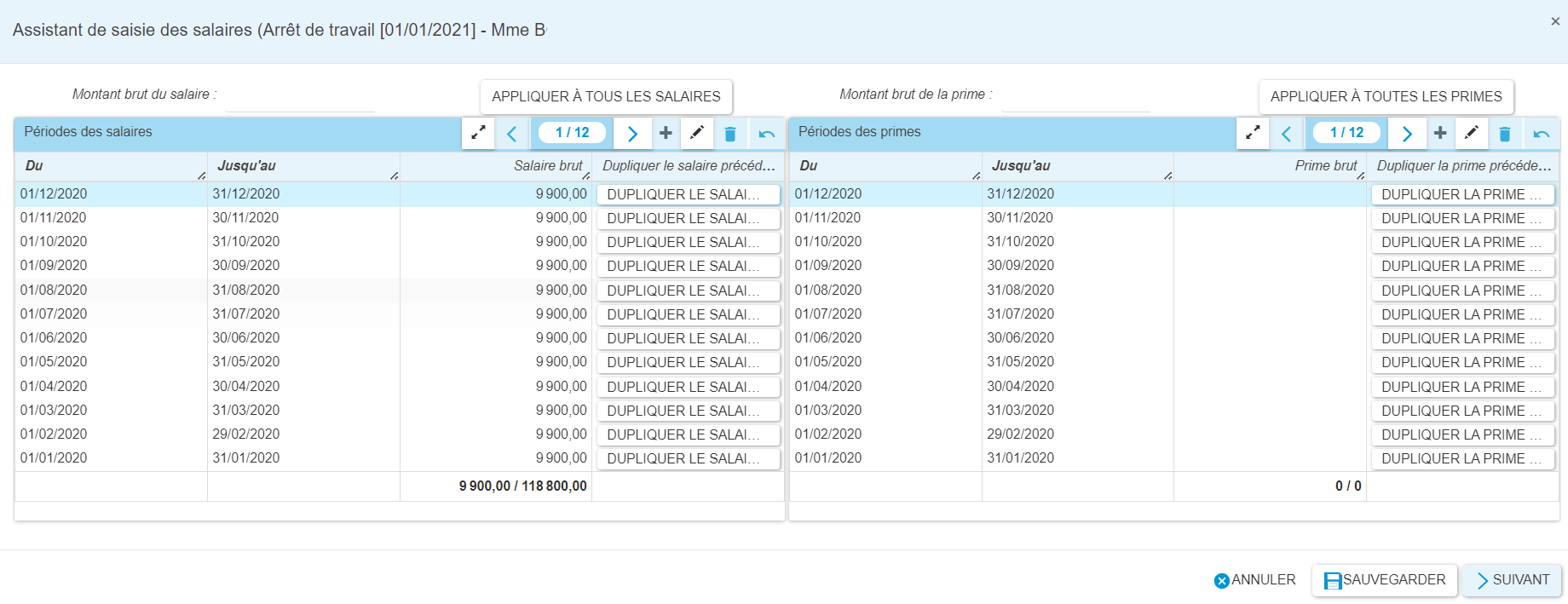
New salary entry wizard
Billing
Payment
Execution log added to payment creation batch
Evolution: add information in execution logs useful for operations teams.
Example: in the event of overpayment, the payment is not created and the information is found in the logs.
Reason and cancellation date added to statement lines
Evolution: the reason and cancellation date are now displayed on statement lines.
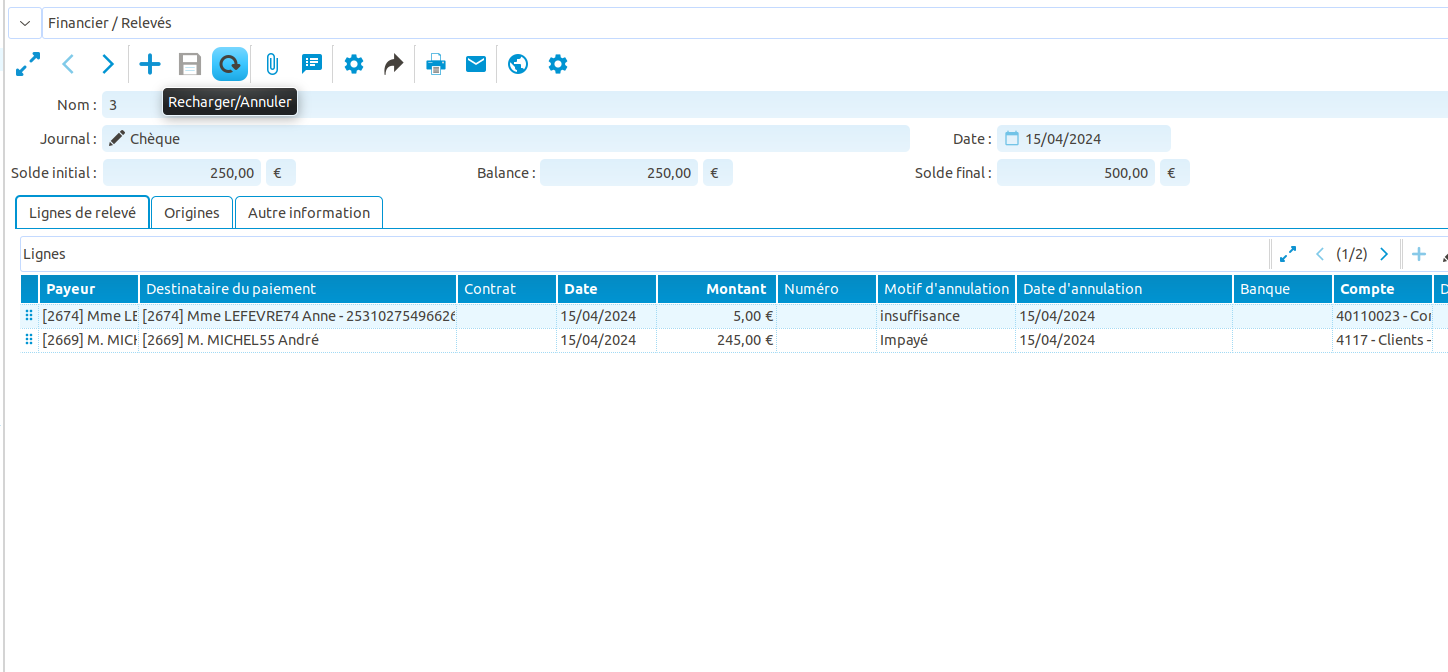
Paybox
Automatic deletion of Paybox payments stuck in “In process” status
Use case
When a policyholder uses Paybox from his or her account to pay outstanding contributions by credit card, a payment line is created in coog.
Previously, if the policyholder closed the browser without completing the transaction, the line remained open and was never closed.
Today, it is possible for a policyholder to retry a payment via Paybox.
Third-party
Automatic identification of country of birth
Developments
- Addition of a new batch that will load the INSEE country reference in addition to the coog country reference (ISO country reference).
- When entering a NIR with a foreign birth department, coog will automatically determine the country using the INSEE reference system.
New implementation of third-party type identification
Context: technical feature that makes it easier to identify third-party configuration/parameters (bank, insurer, broker, etc.).
Evolutions :
- Replacement of checkboxes to identify a natural person / legal entity by a drop-down list (field filled in automatically),
- Creation of a new type of third party “Configuration third party”.
Rules engine
Addition of new rules engine functions to identify whether a subscriber or a covered item has a specific relationship.
- Added functionality for parameterization in the rules engine
- Avoid using the wrong variable name that will cause problems later (reduced risk of error)
- Word-processor-style search thanks to a wizard (simplification)
Creation of accessors to facilitate maintenance and parameterization of data retrieval in rules
Evolution
The accessor makes it easy to extract field data from a rule algorithm, replacing the champs_technique rule engine function.
Simpler and more ergonomic for the user, the accessor is also more technically robust.

Conditional activation of rule debugging mode
Context: this enhancement facilitates configuration in particular bug conditions.
Developments
- Checkbox replaced by a list of choices for debug mode (active, dynamic, inactive),
- Added dynamic mode, which means you no longer get all the debug traces, but only the traces of the rule you’re interested in.
Example: keep only traces of a rule at a specific date.
Removal of a warning when calling a rule function if parentheses are forgotten.
Evolution: make rules more reliable by detecting omissions with a non-blocking warning.
Evolve the “empty table” action into a wizard with the option of deleting dimension values.
Evolution: facilitates configuration by allowing you to empty a table completely, start again more quickly and reload a new table.
Technical core
Added a view to the Celery status viewer to display the number of pending tasks per queue.
Evolution: as part of batch monitoring actions, it is now possible to view the status of the Celery tool (available from “Monitoring” / “Celery status”).
Implementation of a simpler view for Celery node monitoring.
Evolution: ergonomic improvements to the view used to monitor Celery nodes, giving the operator access to more information.
Performance improvements
- Removal of obsolete batch launch module and cleanup of its references
- Deactivation of debug mode on default delivered rules
Trigger a new event when a daily batch is still running.
Evolve: trigger a new e-mail message to warn of problems when the plan has not yet been completed.
coog API
Creation of a new third-party management API (REST / GraphQL)
Adding identifiers to contract search and consultation via GraphQL APIs
Evolution
GraphQL APIs have been enhanced to filter contracts by identifier.
These identifiers are also used when consulting a contract.
Task management API enhancements
- It is now possible to create more different situations per API, notably to facilitate interfacing with an EDM tool (e.g. Open-Capture).
- Integration of third-party creation functionality, either by SIRET number or by Social Security number.
GraphQL task query API
Enhancements to the API for creating bank accounts, with the ability to include a label and usage options (Billing / Claims)
Addition of an API call counter
Upgrade: coog’s Back-Office will be able to display which APIs have been used and which have not.
Comments are closed.